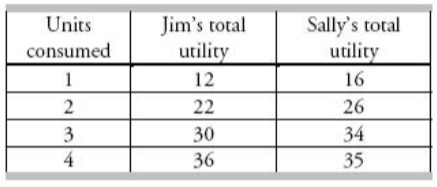
Problem 1. In Figure , which of the following is true?
(a) Jim and Sally have increasing marginal utility.
(b) Jim has increasing marginal utility and Sally has diminishing marginal utility.
(c) Jim has diminishing marginal utility and Sally has increasing marginal utility. (d) Jim and Sally have diminishing marginal utility.
Problem 2. As consumption of a good decreases, its marginal utility and its total utility.
(a) increases; increases
(b) increases; decreases
(c) decreases; increases
(d) decreases; decreases
Problem 3. As long as the marginal utility per dollar spent on pizza is greater than the marginal utility per dollar spent on soda, then to maximize utility a consumer will buy
(a) more soda to equalize the marginal utility per dollar between soda and pizza.
(b) less pizza.
(c) more pizza so total utility will increase.
(d) equal amounts of pizza and soda.
Problem 4. Let MU a and MU b stand for the marginal utilities of apples and bagels. Let P a and P b stand for their prices. The general necessary condition for consumer equilibrium is
(a) MU a = MU b .
(b) MU a = MU b and P a = P b .
(c) MU a P a = MU b P b .
(d) MU a MU b = P b P a .
Problem 5. Ricardo buys cola and popcorn. Cola sells for $0.50 a can and popcorn sells for $1 per bag. He is in consumer equilibrium. The price of a cola jumps to $1 per can. In his new consumer equilibrium, Ricardo’s
(a) marginal utility of cola will be equal to his marginal utility of popcorn.
(b) marginal utility per dollar spent will be 2.
(c) total utility will be higher.
(d) marginal utility of cola will decrease.
Problem 6. Morriss has an income of $100 per week. The price of dog food is $2 per can and the price of cat food is $2 per can. However, there is a volume discount for cat food: If he buys more than 25 cans per week, the price of an additional can is only $1. In Figure , Morriss’s budget line runs through points
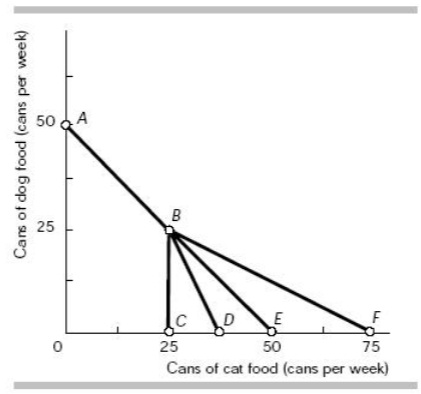
(a) A, B, and C.
(b) A, B, and D.
(c) A, B, and E.
(d) A, B, and F.
Problem 7. In Figure, an increase in income would result in the budget line
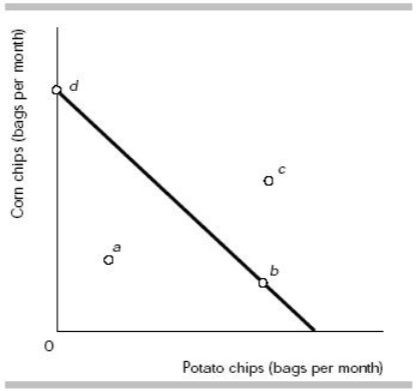
(a) making a parallel shift toward point a.
(b) making a parallel shift toward point c.
(c) becoming flatter.
(d) becoming steeper.
Problem 8. An indifference curve shows:
(a) different combinations of two goods among which the consumer is indifferent.
(b) consumption possibilities that a consumer faces at different prices and income.
(c) affordable combinations of goods.
(d) the opportunity cost of one good relative to another.
Problem 9. A constant marginal rate of substitution between two goods implies that they are
(a) perfect complements.
(b) perfect substitutes.
(c) independent goods.
(d) unattainable.
Problem 10. The indifference curve in Figure
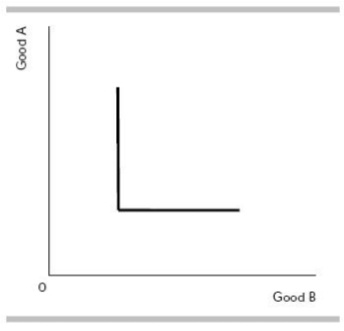
(a) could illustrate a person’s preferences for identical computer disks made by two different companies.
(b) could illustrate a person’s preferences for right-handed and left-handed gloves.
(c) has a constant marginal rate of substitution.
(d) None of the above statements are correct.
Problem 11. Consider the budget line in Figure. If the price of a magazine is $4, then the price of a hamburger is
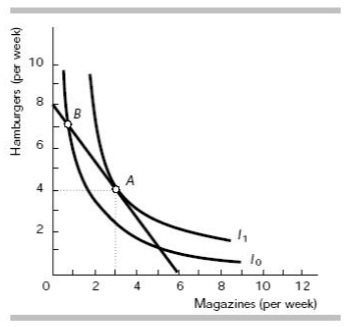
(a) $1.75.
(b) $3.00.
(c) $4.00.
(d) $5.33.
Problem 12. In Figure above, which of the following statements is TRUE? I.The consumer maximizes utility by consuming at point A. II.The marginal rate of substitution at point B and point A are equal because they are on the same budget line.
(a) only I.
(b) only II.
(c) both I and II.
(d) neither I nor II.
Problem 13. In Figure , Reggie’s budget line rotates outward from BL1 to BL2. He initially consumes at point A. If his new consumption bundle is at point B, this implies that kiwi fruit and mangoes are
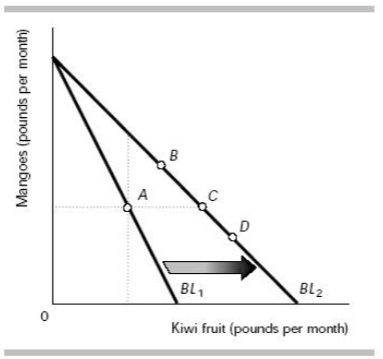
(a) substitutes.
(b) complements.
(c) neither substitutes nor complements.
(d) normal goods